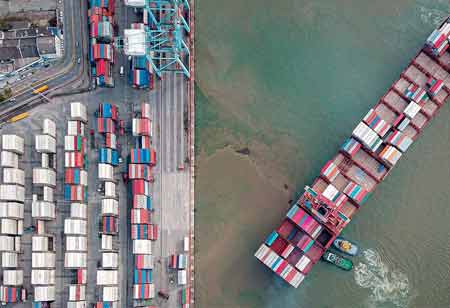THANK YOU FOR SUBSCRIBING
THANK YOU FOR SUBSCRIBING

By
Logistics Transportation Review | Thursday, March 13, 2025
Stay ahead of the industry with exclusive feature stories on the top companies, expert insights and the latest news delivered straight to your inbox. Subscribe today.
Building resilient supply chains and enhancing logistics preparedness through risk assessment, infrastructure investment, technology adoption, and cross-border collaboration is essential for mitigating the impact of natural disasters and ensuring timely aid across Europe.
FREMONT, CA: Natural disasters, from floods and wildfires to earthquakes and severe storms, pose a significant threat to Europe. In an increasingly interconnected world, the resilience of supply chains is paramount to ensuring timely aid and recovery. Effective logistics preparedness is no longer an option but a necessity for mitigating the impact of these events.
Understanding the European Landscape and Challenges
Europe’s diverse geography, encompassing mountainous regions, coastal plains, and remote rural areas, presents significant logistical challenges in disaster preparedness and response. The increasing frequency and intensity of extreme weather events, driven by climate change, further exacerbate these vulnerabilities. Key logistical hurdles include geographical dispersion, which necessitates multi-modal transportation solutions to reach isolated communities; infrastructure vulnerability, where roads, bridges, and ports may be compromised, disrupting supply chains; and cross-border coordination, as disasters often extend beyond national boundaries, requiring seamless collaboration between multiple countries and agencies. Additionally, regulatory complexities, varying national regulations, and customs procedures can delay aid distribution, while climate-related risks such as heatwaves, floods, and wildfires strain infrastructure and operational capacity. The growing threat of cyberattacks on digitised supply chains further underscores the need for robust security measures.
Key Components of Logistics Preparedness
Effective disaster logistics preparedness requires a multifaceted approach that integrates risk assessment, infrastructure resilience, communication systems, and public-private collaboration.
Risk Assessment and Mapping are crucial in identifying vulnerable areas and potential disaster scenarios. Geospatial mapping tools visualise risk zones, infrastructure networks, and evacuation routes. At the same time, institutions like the European Commission’s Emergency Response Coordination Centre (ERCC) and the Copernicus Emergency Management Service provide real-time monitoring and satellite data to enhance situational awareness.
Pre-Positioning of Supplies ensures rapid response capabilities through strategic stockpiling of essential goods, including food, water, medical equipment, and shelter materials. The EU’s rescue capacity bolsters preparedness with stockpiles of medical countermeasures, firefighting aircraft, and other critical assets, while regional hubs and warehouses facilitate swift deployment.
Transportation and Infrastructure Resilience involves diversifying logistics networks by integrating road, rail, air, and maritime routes to maintain supply chain continuity. Investments in climate-resilient infrastructure, contingency planning for disruptions, and the adoption of drone technology for last-mile delivery to isolated areas further strengthen response mechanisms.
Information and Communication Systems underpin coordinated disaster response efforts. Establishing robust communication networks ensures seamless information exchange among responders, aid organisations, and affected communities. Early warning systems play a vital role in disaster preparedness, while interoperable platforms enhance cross-border coordination, exemplified by the Emergency Communication System (ECS).
Coordination and Collaboration between national authorities, international organisations, NGOs, and the private sector is critical to ensuring a unified response. Regular joint exercises and simulations test the effectiveness of preparedness plans, while the Union Civil Protection Mechanism enhances cooperative disaster management across EU member states.
Technology and Innovation in Disaster Logistics
Advancements in technology are transforming disaster response logistics. AI, data analytics, and IoT improve supply chain visibility and efficiency, while drones and autonomous vehicles expedite aid delivery. The integration of blockchain technology is being explored to enhance supply chain transparency. Additionally, mobile applications for disaster management facilitate real-time coordination and resource allocation.
Private Sector Engagement and Adaptation Strategies
Engaging logistics companies in disaster preparedness planning enhances resilience through public-private partnerships. Leveraging private sector expertise and resources accelerates aid deployment and strengthens supply chain networks. Adaptability is essential in disaster response, necessitating rapid damage assessments, flexible logistics operations, and local procurement strategies to support economic recovery while minimising transportation costs. Efficient waste management systems prevent environmental contamination, and integrating logistics considerations into long-term recovery plans ensures sustainable rebuilding efforts.
Emerging Trends and Policy Developments
The European Union increasingly prioritises climate resilience within infrastructure and supply chains, emphasising anticipatory action and early warning systems. Digital transformation, driven by AI and data analytics, reshapes disaster logistics, while increased EU funding supports disaster preparedness and response initiatives. Enhanced cooperation between the EU and member states aims to create a more unified and efficient disaster relief framework, reinforcing Europe’s capacity to mitigate and respond to crises effectively.
Logistics preparedness is a critical component of disaster management in Europe. By investing in risk assessment, pre-positioning supplies, resilient infrastructure, and effective coordination, Europe can strengthen its ability to respond to natural disasters and ensure timely aid and recovery. Continuous adaptation, innovation, and collaboration are essential to building a more resilient and prepared Europe.
I agree We use cookies on this website to enhance your user experience. By clicking any link on this page you are giving your consent for us to set cookies. More info





